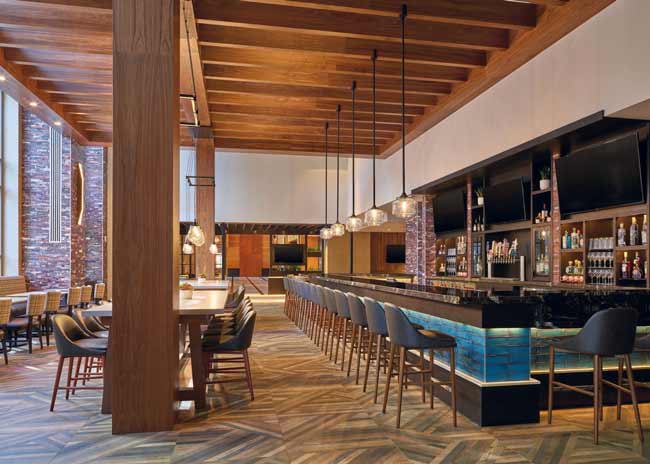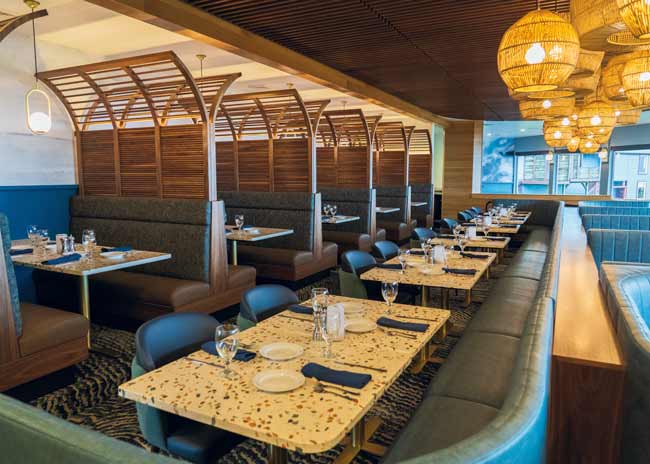After a couple of bleak years caused by the pandemic, the hotel industry may be turning the corner.
Datassential’s Ann Golladay notes that “even in the face of a potential recession, lodging is projected to do better than many other segments in 2023, in part because the segment has yet to reach pre-COVID levels — so they are still making up for lost ground.”
Restaurants and bars could very well present a bright spot in the hotel food and beverage picture with several hotels renovating their spaces to increase business. However, labor issues still plague the operating picture. The labor shortage uniquely affects the type of experience hotel restaurants can provide, particularly for those properties in urban areas, says Doug Roth, founder and president of Playground Hospitality in Chicago. “Because of an occupancy standpoint, if it’s an urban-located hotel, there have been difficulties [in providing] a very different, experiential type of dining,” he says.
 Embassy Suites DC Convention Center. Photo by Shawn O’Conner
Embassy Suites DC Convention Center. Photo by Shawn O’Conner
Sean Callnin, executive principal of Ricca Design Studios in Denver, feels that the current labor shortage is affecting high-end hotels more than other hotels. “The luxury brands are still going to serve their clientele, but they’re going to do it in a more labor-efficient way,” he says. That means most of the workflow or staffing changes will affect the back of the house because “the customer interaction — the experience — requires the human touch, and that’s going to remain the same.”
Embassy Suites DC Convention Center in Washington, D.C., recently underwent a $32 million renovation that modernized all areas of the hotel and introduced a new on-site restaurant, Brickstones Kitchen & Bar. The new dining options brought with it new cleaning protocols, something that has become more of the norm among restaurants following the pandemic.
David Kasprzyk, general manager of the Embassy Suites DC Convention Center in Washington, D.C., says that the hotel has moved cleaning from behind the scenes out into the open. “While the culinary teams have always followed strict cleaning and food handling standards, communicating and showing that to our guests is now a priority,” he says. “This new priority allowed our teams to reinvent our processes and ensure they are visible and guest-facing to elevate our guests’ sense of service and safety.”

Thinking Locally
Another change at Kasprzyk’s Embassy Suites location: The site has teamed up with an on-demand mobile ordering system to provide, as he calls it, a “knock and drop” experience similar to the delivery format guests are now familiar with. “The pandemic showed that guests had embraced in-room dining as they accepted the pricing in exchange for convenience and value,” he says.
Years ago, the idea of having food from an outside vendor brought into a hotel was frowned upon, if not outright verboten. But with the rise of third-party delivery services and the concurrent cutting back on some hotel F&B programs and hours, hotels are coming to accept — and in many cases, even embrace — delivery services. Much of hotel F&B “is overwhelmed,” says Roth, “and as a result, if there’s any opportunity to mitigate the guest frustration, then they’ll go for it. Unless you’re a very high-end brand, [delivery] is here to stay.”
Some hotels continue to rethink their restaurants to attract more residents of the surrounding neighborhoods. It starts with a distinctive concept that’s not readily available in other nearby restaurants, says Callnin, “so it’s not only something that’s unique for the hotel guests, but unique for the surrounding area.” He also suggests promoting it as simply a restaurant — not a restaurant in a hotel — can prove beneficial. He cites a recent visit to a Mediterranean restaurant in Denver, noting that from its marketing, “you couldn’t even tell it’s in a hotel.”
Kasprzyk agrees that it’s necessary to broaden the customer base and be part of the local community, and his hotel uses social media for that. Through social media, he says, the hotel and its chefs can “create publicity and achieve that recognition that was not necessarily [previously] available.”
Callnin adds that hotel restaurants have to up their game to match diners’ preferences. “People do their research, and they go where they want to go to get the atmosphere and the food that they want. If it’s in a hotel, it’s in a hotel. So it’s up to the hotel to do the market research and have the in-house team to develop the concept that fills the gap in that area.”

Design Considerations
As hotel restaurants look to maximize front-of-house space for both economic and safety reasons and readjust their menus, operators will have to rethink kitchen design and equipment choices.
For example, Callnin sees a reversal of the recent trend toward open kitchens. While the open or exhibition kitchen conveys the benefits of fresh preparation to diners, going back to a “closed” kitchen allows operators to be more “nimble with labor,” he says. “As design consultants, we’ve always been careful about splitting away stations from the main cookline. If you enclose the kitchen, you start to look for labor efficiencies in the back of house. If there’s a beautiful pizza oven or a wood-burning grill that’s important to your concept, put that out front, and in the back, you can be completely flexible about the equipment that you need,” he says.
Due to the labor crunch, Roth says, “There are issues with a sense of timing and getting product out of the kitchen.” On a recent hotel job, he specced a holding cabinet, a combi oven, an impinger oven and other labor-saving equipment. “When you have a mix of these systems, you’re reducing the amount of labor. But you’re now moving from line people to technicians,” he says. “As long as they’re able to produce the high-quality level of product that’s insisted by many restaurant/hotel groups, then I think that’s the direction we’ll be seeing.”
The kitchen at the Embassy Suites DC has moved toward more time- and labor-saving equipment, says Kasprzyk, with a speed-cook oven being a particular favorite. “Previously, we would use a convection oven but now have an oven that provides a high-quality product, consistently and efficiently,” he says. “Our older equipment did not allow for that type of consistency in a considerably shorter cooking time.”
No matter what equipment a hotel F&B operation uses, it all comes down to delivering a quality final product and being flexible enough to roll with the changes, Kasprzyk adds. “In this new environment, it is a luxury to have a restaurant in a hotel; therefore, we have to evolve as our guests do and change as the trends change.”
 Drafting Table Located inside the Hotel Indigo Atlanta Downtown, The Drafting Table hits many of the key themes happening in the hotel restaurant space today. Notably, the restaurant functions as a local establishment while also functioning as a dining space for hotel guests. Atlanta-based Legacy Ventures manages both the restaurant and the hotel.
Drafting Table Located inside the Hotel Indigo Atlanta Downtown, The Drafting Table hits many of the key themes happening in the hotel restaurant space today. Notably, the restaurant functions as a local establishment while also functioning as a dining space for hotel guests. Atlanta-based Legacy Ventures manages both the restaurant and the hotel.
Refreshing a Concept to Draw Business
At the Hallmark Resort in the oceanside town of Newport, Ore., the rooms have stunning views of the Pacific Ocean, as do the tables at the hotel’s restaurant, Georgie’s. “We are in a very seasonal location,” says Ric Rabourn, president and CEO of Hallmark Inns and Resorts, “and locals make up a significant amount of our business most of the year. Georgie’s has always valued our local guests.”
After more than 20 years without a major renovation, Hallmark recently undertook a major refresh of Georgie’s interior, reconfiguring it to provide increased seating capacity and “to upgrade the interior design and ambience to match the quality of the food, service and view,” says Rabourn.
The hotel also wanted to provide a better experience for guests waiting for a table. “We extended the entry vestibule to create a bistro lounge area where guests could order a drink while waiting for a table,” says Jaime Merrill, hospitality design leader for design firm Oculus Inc. The redesign of the lounge area helped reposition the restaurant as not just a dinner choice but also “a spot for a romantic date night or after-dinner drink,” she says.



